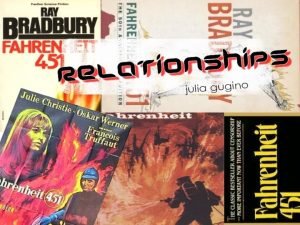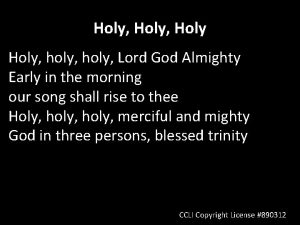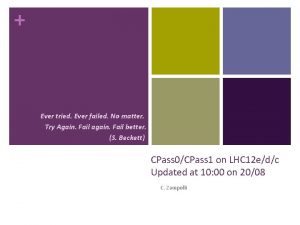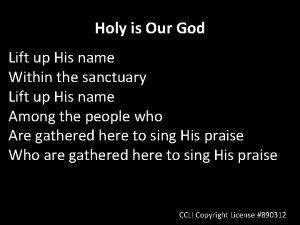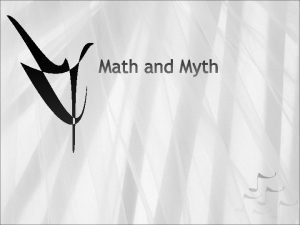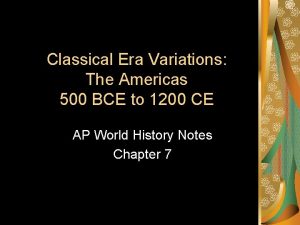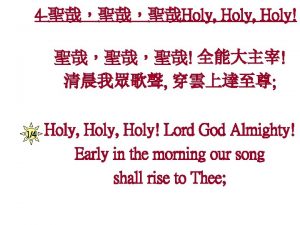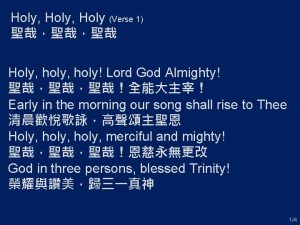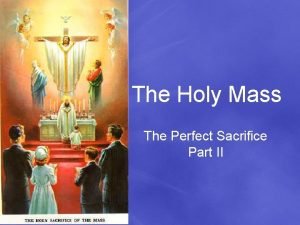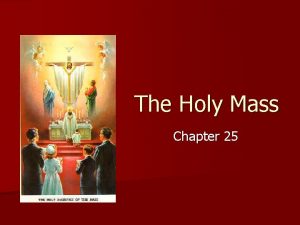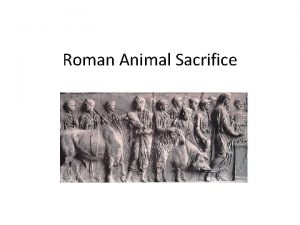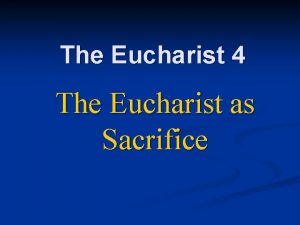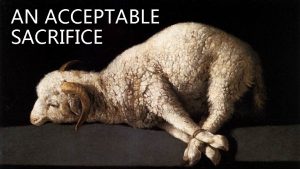The Holy Sacrifice of the Mass Ever Ancient




























- Slides: 28

The Holy Sacrifice of the Mass… Ever Ancient… …Ever New!

Sunday Liturgy The most concrete and fundamental way for the family of God to gather and express its belief and union. Holy time…Holy place!

Sunday Liturgy …Sacred signs …Sacred symbols …Sacred gestures …Sacred language …Sacred ritual

Sunday Liturgy The Mystical Body of Christ assembled in prayer!

Sunday Liturgy Unity of language, gesture, expression and meaning throughout the world!

…Sacramentary (book which contains the words and instructions of the Mass) will now be known as the Roman Missal …New translation is not changing the sacred liturgy …New translation is changing some familiar words and expressions found in the Mass.

Why a new translation? New translation: o is more faithful to original Latin o safeguards a common and universal language of prayer.

Roman Missal: A Brief History Prior to Vatican Council II (1962 -65), Latin was the only language used for the celebration of Mass throughout the world!

Roman Missal: A Brief History o o o 1962 (Vatican II): Mandates use of the vernacular (language spoken by people) 1973 -74: first official English translation known as the Roman Missal approved for use by US Bishops 1985: second edition published known as the Sacramentary

Roman Missal: A Brief History o 2000: John Paul II mandates all translations in conformity with original Latin text for linguistic integrity. 2001: “Liturgical Authenticum” gives guidelines for translation from Latin to vernacular o

Roman Missal: A Brief History o 2007: Ratio Translationis for the English Language 2011: First Sunday of Advent implementation of the Roman Missal o

Translation into the Vernacular “Dynamic equivalency” used for original translation (1973 -74) from Latin to English. o “Dynamic equivalency” expresses the familiarity of the language. o English is not a richly endowed language. o Accuracy of classical Latin lost in “poverty” of modern English. N. B. : Many third world countries used this translation o of English as basis for translation into their vernacular.

Translation into the Vernacular o o o “Formal equivalency” mandated by “Liturgical Authenticum” for translation into the vernacular (2007) Closer conformity to theological and scriptural foundations of the Latin Mass Greater unity of theological concepts in prayers of the Mass in all languages

A Look at Some of the Changes The Introductory Rites Greeting Priest: The Lord be with you. People: And with your spirit. o Penitential Act: Form A (Confiteor) & Form B o The Gloria o o Collect

A Look at Some of the Changes The Liturgy of the Word o Gospel Dialogue o Nicene Creed o Apostles’ Creed

A Look at Some of the Changes The Liturgy of the Eucharist o Suscipiat Dominus o Preface Dialogue o Sanctus o Mystery of Faith

A Look at Some of the Changes The Communion Rite o Sign of Peace o Ecce Agnus Dei

A Look at Some of the Changes The Concluding Rites Priest: The Lord be with you. People: And with your spirit.

Catechesis of Students Historic opportunity to deepen the student’s understanding of the Mass!

Catechesis of Students …Discussion of sacred language …Understanding of Biblical sources

Catechesis of Students …Recall of liturgical gestures …Understanding the words we pray

Catechesis of Students …Reflection on full, active participation by attention to what we say and do!

Catechesis of Students o o o Practical Suggestions Use tri-fold brochure with changes from Office for Catechetical Formation Use opening and closing prayer to introduce a new response Teach/practice responses at a general assembly.

Catechesis of Students o o Practical Suggestions Introduce Confiteor, Gloria and Creed after responses are mastered Welcome students at arrival with the new greeting Practice parts at home Review mastery with worksheets (see next slide)

A complete set of Mastery Sheets are posted at: http: //archphila. org/ catechetical/resource s/resources. htm (Roman Missal)

Sacred Liturgy, Music and the Non-musician; Non-liturgist Resources to promote universal and common body of music o Principles of Progressive Solemnity --indicates Mass parts to be sung; nature and style of compositions o New compositions for Mass settings and parts to reflect changes o Office of Worship’s recommendations o

Resources Books and Articles o o o o For catechists: Turner, Paul. Understanding the Revised Mass Text, 2 nd ed. , Archdiocese of Chicago: LTP, 2010 (50 copies+ = $1) For families: Kelly, Maureen A. What’s New About the Mass, Archdiocese of Chicago: LTP, 2011. (50+ copies = $1) Recommended for 3 rd through 7 th level catechesis; Teen copy also published. Mick, Rev. Laurence, Catholic Update, “Changing How We Pray, ” St. Anthony Press, August 2010. Hilgartner, Rev. Richard, Catholic Update, “The Roman Missal, ” St. Anthony Press, March 2011. (Good for the principles of the new translation) Mahoney, Most Reverend Roger M. , “Welcoming the New Roman Missal, ” America, Vol. 204, #17, May 23, 2011, pp. 10 -12. For Music: Sing to the Lord, “Music in Divine Worship, ” Washington, DC: USCCB, June 2008. Four-Part Commentary on this Document: Today’s Liturgy, Epiphany 2009, #1; Easter 2009, #2; Ordinary Time 2009, #3 and #4.

Resources o o o o o Web Sites: www. Loyolapress. com Webinar by Joe Paprocki; Three-20 min. segments for catechists. http: //archphila. org/catechetical/resouces/resources. htm. www. usccb. org/romanmissal (Click “Resources” and then “Free Resources”) www. romanmissalchanges. com www. osvcurriculum. com/romanmissal www. revisedromanmissal. org www. ltp. org www. andwithyourspirit. com Publishing Company websites.
 Ever ancient ever new
Ever ancient ever new Clarified it
Clarified it Ever ancient ever new
Ever ancient ever new Holy holy god almighty the great i am
Holy holy god almighty the great i am Holy are you lord holy is your name
Holy are you lord holy is your name Ever tried ever failed no matter
Ever tried ever failed no matter Deuteronomy 20:8
Deuteronomy 20:8 Be holy for i am holy
Be holy for i am holy Lift up his name
Lift up his name Holyhol
Holyhol Names of the holy spirit
Names of the holy spirit Ever since ancient times
Ever since ancient times The largest gold nugget ever found had a mass of 100 ____.
The largest gold nugget ever found had a mass of 100 ____. Ancient india vs ancient china
Ancient india vs ancient china Ancient means of communication pictures
Ancient means of communication pictures Sacrifice feast
Sacrifice feast For every decision you make there is a trade off
For every decision you make there is a trade off Saffron stands for
Saffron stands for What pleases god
What pleases god There is either obedience or the church
There is either obedience or the church Chapter 22-23 kite runner
Chapter 22-23 kite runner Dont sacrifice pervades your mahal india
Dont sacrifice pervades your mahal india Pok a tok sacrifice
Pok a tok sacrifice Hebrews 9 niv
Hebrews 9 niv To obey is better than sacrifice lyrics
To obey is better than sacrifice lyrics The lottery sacrifice
The lottery sacrifice Living sacrifice lyrics
Living sacrifice lyrics Sacrifice
Sacrifice Reasonable sacrifice
Reasonable sacrifice

